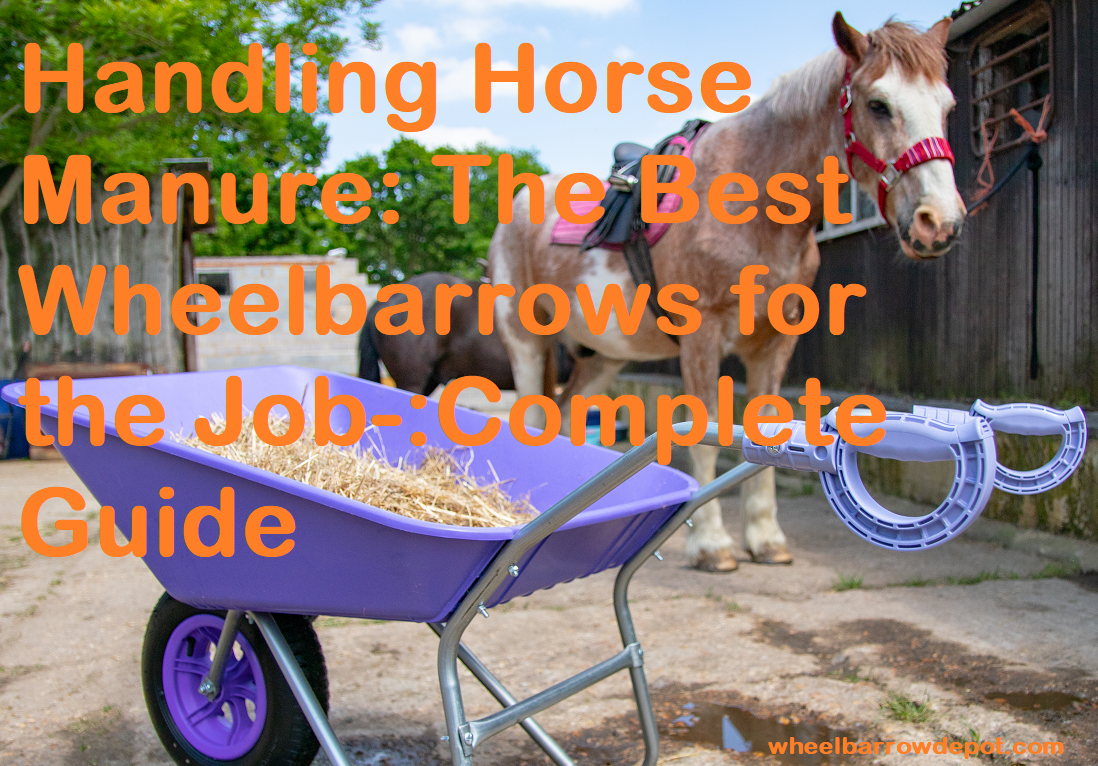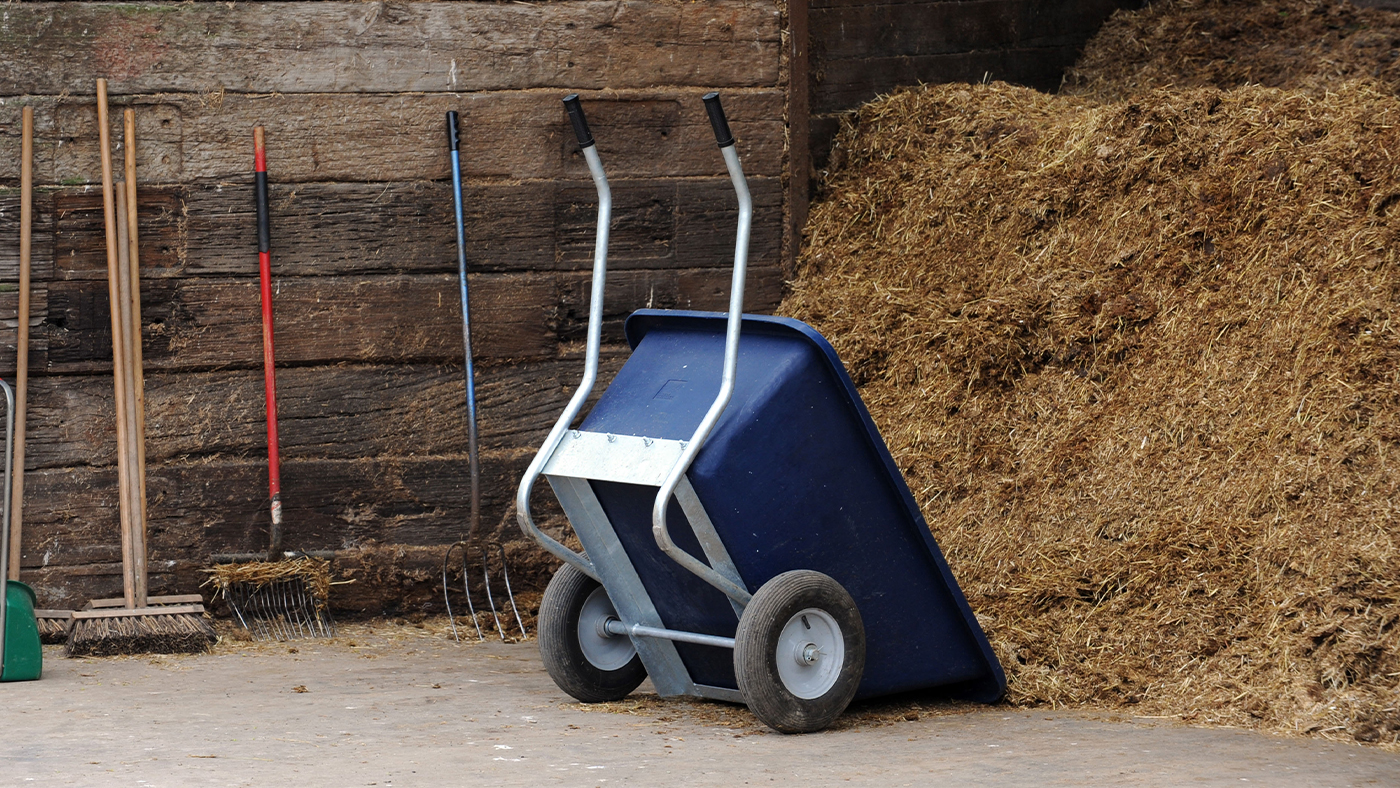Are you having a hard time managing horse manure? Have you been searching for the right wheelbarrow to make the job easier? Then look no further!
Here is a comprehensive guide which will help you pick out the best wheelbarrow for the job.
Managing horse manure is an important part of any stable owner’s job. Not only does it have to be handled correctly and safely, but the right equipment for the job can make the task easier and more efficient. In this guide we’ll explore what makes a wheelbarrow ideal for collecting and disposing of manure, as well as looking at some of the most popular models available.

Factors to Consider When Choosing a Wheelbarrow for Handling Horse Manure
A wheelbarrow is an invaluable tool for anyone who must handle large volumes of horse manure on a regular basis. Selecting the right wheelbarrow is essential to ensure that the job is done efficiently and safely. There are many factors to consider before purchasing a wheelbarrow. It’s important to take into account the weight of the load, terrain, comfort level required, storage space and budget.
Weight Considerations The capacity of a wheelbarrow will vary significantly depending upon its size as well as its materials. Knowing the approximate weight of your average load will go along way in determining which type and size of wheelbarrow you need. It’s also important to consider if you need your wheelbarrow to be able to carry heavier items such as feed bags or fertilizer bags in addition to standard loads.
Terrain Considerations It’s important that your wheelbarrow can move easily over whatever terrain you may encounter when handling horse manure. Different types of wheels are suitable for different terrains; therefore it is important that you choose accordingly depending on whether you need more traction or maneuverability in certain areas.
Storage Considerations Many stables have limited space for storing tools, so it pays to take into account size when selecting a wheelbarrow for horse manure handling. If storage options are limited look for a wheelbarrow with collapsible handles and removable wheels that allow it to be stored flat and out of the way when not in use.
Capacity
When handling horse manure, one of the most important factors to consider is the capacity of the wheelbarrow. Horse manure can range in weight, from 50-180 pounds per cubic foot, depending on moisture content and texture. For this reason, it is essential to have a wheelbarrow that can handle this wide variety of weights.
The capacity of a wheelbarrow is determined by its overall size and the size of its bucket or tray. While larger buckets can handle more manure, they are also heavier and more cumbersome to maneuver around tight corners, trails and uneven terrain. When selecting a wheelbarrow for horse manure, it’s important to choose one that has sufficient capacity to handle all varieties but isn’t so large or bulky that you will tire quickly with each load.
Most residential-grade wheelbarrows are available with capacities between 8-12 cubic feet and are suitable for light-duty loads only. If you plan to use your wheelbarrow for multiple purposes, like loading hay bales or mulch bags along with random piles of horse manure then a larger capacity is recommended; choose a medium duty model with a capacity between 10-14 cubic feet for best results. For commercial or heavy duty applications look for models with 15+ cubic feet capacities.
Remember — select a size based not only on the task at hand but also on how comfortable you feel using it over long periods of time. It’s no fun pushing hundreds of pounds if your arms grow tired after 20 minutes!
Material
When selecting the right wheelbarrow for handling horse manure, there are a few key factors you should consider. It’s important to select a wheelbarrow that is made out of durable and corrosion resistant material such as polyethylene, steel or composites. Steel is probably the strongest and most durable material, but it can be expensive and also prone to rusting. Polyethylene can be reliable, but it tends to be more costly than other materials. Composite materials offer great value for money, but they can be prone to cracking under heavy loads.
It’s also important to ensure that your wheelbarrow has sturdy handles and large metal supports for added stability when manoeuvring loaded wheelbarrows. The size of your wheelbarrow is important too; you should choose one in accordance with the quantity of manure you will be working with on a daily basis.
III. Types of Wheelbarrows Suitable for Handling Horse Manure
Wheelbarrows are a great way to move horse manure from the paddock to the compost pile. There are a variety of different types of wheelbarrows on the market, with each type having its own advantages and drawbacks. Depending on the size and type of job you are doing, it is important to choose the right wheelbarrow for the task at hand. Here is a breakdown of the most common types of wheelbarrows available and how they might be used in manure removal:
- Two-wheeled barrows: These barrows have two large wheels at either end, making them easy to steer around corners or over difficult ground. They provide stability when carrying heavier loads but can be hard to maneuver when full due to their weight and bulk.
- Three-wheeled barrows: These have three smaller wheels, offering more maneuverability than two-wheeled barrows. They can handle heavier loads than traditional two-wheeled models but can often be difficult to turn quickly while loaded with large amounts of manure.
- Four-wheeled barrows: These have four wheels mounted on both sides which provides greater stability while transporting heavy loads over rough terrain as well as improved traction during turns due to higher center mass on each side of the load box. Four-wheeled models can also be more expensive than other types of wheelbarrow but offer better control and maneuverability when handling large amounts of horse manure around your property or farm yard.
Traditional Wheelbarrows
The traditional wheelbarrow, sometimes referred to as a farm wheelbarrow, is much sturdier than the plastic ones you find in retail stores. Traditional wheelbarrows are ideal for carrying and dumping heavier loads, making them perfect for handling horse manure.
The metal frames are galvanized to give them extra protection against corrosion and rusting, and they come with an axle bar to ensure the load remains balanced while transporting. The big rubber tire provides a more controlled turning radius when carrying larger loads as well as better grip on surfaces, enabling you to move more quickly from one place to another without worrying about the weight of the manure you are handling.
Traditional wheelbarrows also come with larger capacity trays that make it simpler for horse owners to handle the amount of manure produced by their animals.
Two-Wheeled Wheelbarrows
Two-wheeled wheelbarrows are considered the most common type of wheelbarrow around for home use as well as for hobby gardeners and professional landscapers, who generally move heavy loads. Two-wheeled wheelbarrows have a single pair of wheels, a long handle and a hopper for loading soil and other materials. This type of wheelbarrow is easy to maneuver in tight areas and can be used in constrained spaces due to its size. Additionally, it is often considered the most stable option since it has two separate points of contact with the ground.
The two-wheeled wheelbarrows are also durable, because they can handle various types of terrain including gravel driveways, mud pits and more. The large capacity bin further allows you to easily move large loads with one go and get the job done quickly. As a result, these wheelbarrows can be great equipment if you’re dealing with a lot of horse manure on your property or if you need to haul supplies around your farm or yard frequently. They require minimum effort when loaded properly which makes them efficient tools for moving materials with ease.
Electric Wheelbarrows
Electric wheelbarrows are an ideal solution for horse owners who need to maximize their time or reach a variety of areas with a single tool. They allow you to work efficiently and safely, removing organic materials safely and effectively with minimal effort on your part. Electric wheelbarrows come in different shapes and sizes, but they all offer the same convenience — the power to move large amounts of material with less effort.
Electric wheelbarrows are mainly used for collecting manure from stalls, fields, or mass clean up efforts. Despite how challenging it can be to maneuver shovels and buckets by hand, electric wheelbarrows make it easier to transport manure out of busy areas quickly and reduce fatigue thanks to the added power boost that comes as standard.
The models available in most stores include features such as adjustable handles for better control; large capacity cargo bins; powerful motors; remote starters; and more safeguards such as overload protection. The terrain wheels on many models also provide superior traction when shifting over wet terrain or sand. Electric wheelbarrows can generally carry up to 600 pounds without struggling while still being lightweight enough to move around easily in smaller areas such as stables or pens – perfect for cleaning out horse enclosures efficiently!
Garden Carts
Garden carts are an ideal option for those who need to occasionally haul large amounts of material. Fitted with pneumatic wheels, garden carts are capable of traversing rough terrain while supporting loads lasting up to 400 pounds. This makes them a great option for handling horse manure in the barnyard or around the paddock without causing damage to the environment.
Furthermore, they are just as adept at transporting goods around well-manicured turf or urban landscapes. Their stability also ensures that your job is done quickly and efficiently.

Maintenance and Care Tips for Wheelbarrows
Proper maintenance and care of a wheelbarrow can help ensure its safe and successful use for the long term. Here are some maintenance and care tips that can help extend the life and performance of your wheelbarrow:
-Check for damage or wear before use. Before using, always inspect your wheelbarrow to be certain there is no visible sign of damage or excessive wear. If you find evidence of such, discontinue use until the issue is corrected by a qualified service technician, or unless specified in your user manual.
-Check all hardware components periodically. Make sure to check all nuts, bolts, pins, retaining rings and other fasteners that secure the wheelbarrow frame, handlebars, wheel axles and any associated parts for tightness prior to each use.
-Ensure proper lubrication of key friction points. The wheel axle area must be lubricated with a quality lubricant or waterproof grease before each use as this will help prevent premature heavy wear in this area; obey any instruction manuals accompanying your wheelbarrow when doing so. Consult with a manual if unsure what type of lubricant to use as product specifications may vary from manufacturer to manufacturer.
-Avoid dragging or rapid usage while wheeling loads over rough surfaces. Damages such as broken rivets, axels fractures and weak welds are common when incorrect usage occurs on complicated terrain; assessing loading speed is paramount in preventing damage to any wheeled platform including the wheelbarrow structure itself.
-Periodically clean the structure with soap and water solution if applicable; manufactured painted finishes on steel structures should not be affected should natural contact with materials occur during work sessions. Additionally keep products clear from sand accumulations on tires by using compressed air from time to time as these accumulations can alter terrain stability.
Cleaning and storage tips
Once you’ve removed the horse manure from your property, it is important to properly clean and store your wheelbarrow for future use. While the job of handling horse manure can be a dirty one, with a few simple steps you can ensure that your wheelbarrow stays in good shape for years to come.
Clean-up- After every use, remove any remaining debris from the bottom of your wheelbarrow and hose down all surfaces with warm water. Ensure no chunks of manure or dirt remain in or on the wheelbarrow. If necessary, use a stiff bristled brush to scrub away any dried up matter. Let all areas dry completely before storing until next time.
Storage – As long as all surfaces are dry, store your wheelbarrow upright in a spot that has good air flow; do not cover or keep it in a confined space as this may create rust and cause damage over time. Additionally, be sure to raise the front end by placing stones underneath; this will enable better drainage and help avoid premature rusting.
A good quality wheelbarrow made specifically for handling horse manure can make efficient work of keeping your stables and pastures clean – and having these helpful cleaning and storage tips at hand will follow to ensure that you get the most out of it for years to come!
Regular maintenance practices
Maintaining and caring for your horses is not only a responsible practice, but it’s also a crucial part of any horse owner’s job. Regular maintenance practices should include cleaning stalls and cleaning up general debris across your property. One of the most important tasks a horse owner has is controlling manure, which can have an impact both on the health of humans, other animals and the environment as a whole.
There are many benefits to taking control of your horse’s manure. Proper storage and handling will help to manage pests, reduce odors, reduce fly infestations, reduce the potential for contamination in streams and ponds, reduce overall weed competition with surrounding plants and support the overall health of neighboring plants and animals. Choosing the right equipment for removing and handling manure is key to tendering to this important task.
The two main pieces of equipment you will need for tending to our horses’ excrement are a wheelbarrow or dump cart and a pitchfork or spade. These tools come in various sizes; while choosing one that fits your needs, consider facets such as weight capacity, tire size/type, composting vs manure storage capability lighted frames/wheels) Ease-of-use should also be considered — ergonomic designs that feature wheels that make handling heavy loads easier are out there. There are plenty of features available among wheelbarrows from all sorts of manufacturers from lightweight polyethylene units to heavy duty iron models. Additionally look for models with corrosion resistant components like plastic bins or galvanized steel parts – whir you’re dealing with manure products you want non-corrosive materials under stress!
Conclusion
To sum up, it’s important to select the right wheelbarrow depending on your needs and preferences. For those with limited space, a plastic or folding wheelbarrow is ideal, while yard professionals will benefit from more robust designs like a steel or professional wheelbarrow. Before making your final purchase decision, it’s important to consider factors such as portability, stability and ease of maintenance.
Finally, when it comes to horse manure tasks, gloves and face masks are an absolute must! We hope this guide has adequately addressed the key points you need to be aware of when making your selection for the perfect wheelbarrow for your horse-related tasks.
FAQ’s
What is the best wheelbarrow for horse manure?
A wheelbarrow with a sturdy and durable construction and large capacity is best for horse manure.
What is the best tool for picking up horse manure?
A manure fork with wide tines and a sturdy handle is the best tool for picking up horse manure.
How do you manage horse manure?
Horse manure should be regularly removed from the stable or pasture, stored in a designated area, and properly disposed of or used for composting.
What is horse manure used for?
Horse manure can be used as a natural fertilizer for gardens and crops, or as a source of fuel for heating and electricity generation.
What is the fastest way to break down horse manure?
Adding organic materials like straw or wood chips, turning the pile regularly, and keeping it moist can speed up the decomposition of horse manure.
How to make a manure bin for horses?
A manure bin for horses can be made by building a frame from wooden pallets and lining it with wire mesh or plywood.
Which manure is best manure?
Composted manure is considered the best manure as it has broken down into a nutrient-rich soil amendment.
What is the best use for manure?
Manure is best used as a natural fertilizer to improve soil quality and promote healthy plant growth.
What is best cow or horse manure?
Both cow and horse manure have similar nutrient compositions and can be equally beneficial for fertilizing gardens and crops.
What is the best plants to put in a wheelbarrow?
Plants that do well in containers, such as herbs, flowers, or small vegetables, are best for planting in a wheelbarrow.
See more-
- Best wheelbarrow for home use 2023
- Best electric wheelbarrow 2023
- Best wheelbarrow for horse manure 2023
- Best ergonomic wheelbarrow 2023
- Best wheelbarrow for landscaping 2023

Richard Tolliver is a seasoned author and the CEO of a popular wheelbarrowdepot and informative website. With a degree in Horticulture from the University of Missouri, he worked as a professional landscaper and garden designer for several years. His website, founded in 2010, offers comprehensive and unbiased reviews of the best wheelbarrows available in the market, helping readers make informed decisions based on their needs and budget. His expertise and knowledge have been recognized by industry professionals, and he continues to inspire gardening enthusiasts and outdoor enthusiasts alike with his personal experiences and tips on creating beautiful and sustainable outdoor spaces.

